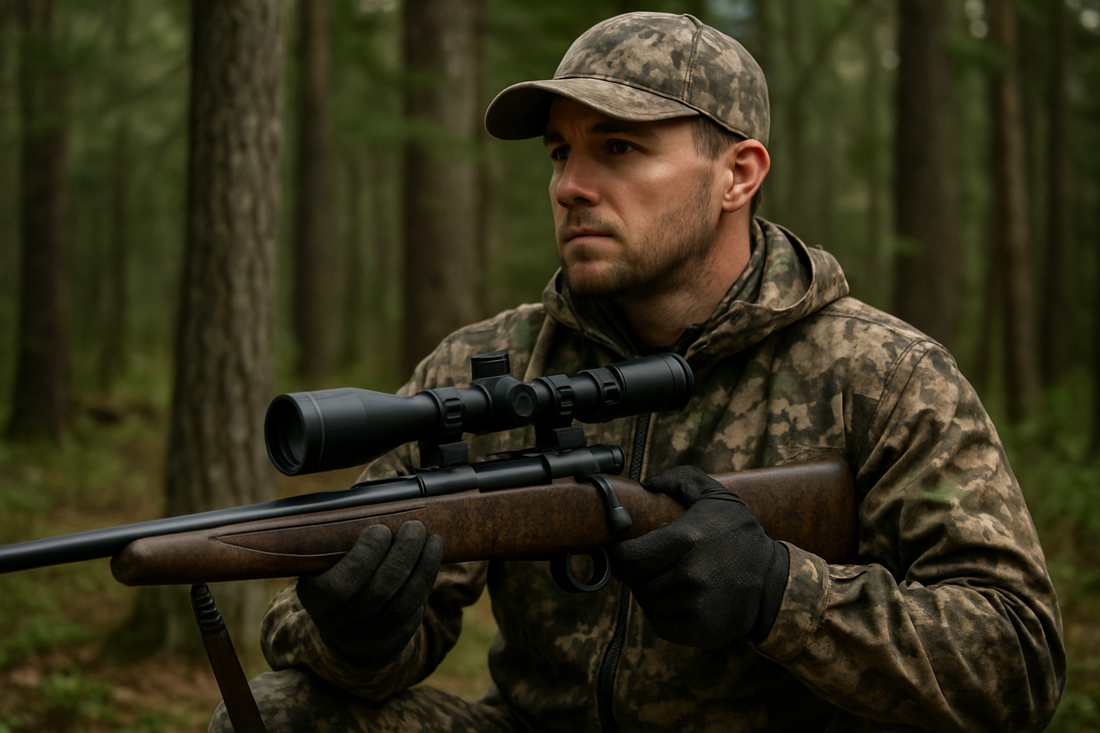
How to Choose the Right Magnification and Objective Size for Your Riflescope | MCJ Optics
Share
How to Choose the Right Magnification and Objective Size for Your Riflescope
As a shooter or hunter, your riflescope isn’t just glass on your rifle — it’s your link between the target and a clean, ethical shot. Understanding how magnification and objective lens diameter work together is key to getting the most out of your optic, whether you’re tracking deer in thick timber or hitting steel at 500 yards.
1. Understand What Magnification Actually Means
Magnification describes how much closer an image appears compared to the naked eye. A 3–9× scope means the image appears 3 to 9 times larger than with your unaided eye.
- At 3×, you get a wide field of view — perfect for fast-moving game or close encounters.
- At 9×, you see finer detail for long-range precision, but with a narrower view.
Optical fact: As magnification increases, your field of view decreases, and image brightness slightly reduces due to a smaller exit pupil.
2. Match Magnification to Target Distance and Terrain
| Hunting Situation | Typical Distance | Recommended Magnification Range | Why |
|---|---|---|---|
| Dense woods / brush | 25–150 yds | 1–6× or fixed 4× | Wider FOV for quick target acquisition |
| General big game (deer, boar, coyote) | 100–300 yds | 3–9× or 4–12× | Versatile balance of speed and precision |
| Open country / mountain hunting | 200–600 yds | 4–16× or 5–20× | More magnification for long-range clarity |
| Precision or varmint shooting | 300–1,000+ yds | 5–25× and above | Fine aiming for small, distant targets |
Factual takeaway: For most hunting under 400 yards, magnification beyond 12× rarely improves accuracy. Skill, rifle zero, and stability matter more than raw zoom power.
3. Understanding Objective Lens Diameter
The objective lens (the front glass) controls how much light enters your riflescope. It’s measured in millimeters — for example, “40mm” or “50mm.” Larger objectives collect more light, producing a brighter image in low light, but also add weight and require higher scope mounts.
Optical principle: Exit pupil (apparent brightness) = Objective Diameter ÷ Magnification
Example: A 3–9×40 scope at 5× has an exit pupil of 8mm (bright); at 9×, it’s 4.4mm — still fine for daylight, but dimmer in twilight.
Since the human eye dilates to about 7mm in low light, an exit pupil between 4–6mm offers the best balance for dawn or dusk hunting.
4. Balancing Magnification and Objective for Real Use
| Scope Configuration | Best Use | Pros | Trade-offs |
|---|---|---|---|
| 1–6×24 | Close-range or fast-action shooting | Ultra-wide field of view | Limited reach beyond 250 yds |
| 3–9×40 | All-around hunting | Perfect balance of size and clarity | Slightly dimmer at full zoom |
| 4–12×44 | Medium to long-range use | Clear optics and extended range | Added weight and smaller FOV |
| 5–25×50 | Long-range precision | Superb detail for distance | Heavy, large mounts, not ideal for quick shots |
5. Practical Decision Formula
Here’s a simple way to find your perfect riflescope setup:
- Step 1: Determine your average hunting or shooting distance (D).
- Step 2: Multiply D (in yards) × 0.015 = baseline magnification.
- Example: 250 yards × 0.015 = ~4× → Choose 3–9× or 4–12×.
- Step 3: Objective diameter ≈ max magnification × 4 for a bright image.
- Example: 9× × 4 = 36mm → a 40mm objective is ideal.
6. Additional Technical Considerations
- Low light hunting: Choose 42–50mm objectives; keep magnification under 10× at dusk.
- High recoil rifles: Maintain at least 3.5" of eye relief for safety.
- Weight & balance: Every 10mm increase in objective adds ~25g and may raise your mount height.
- Cheek weld alignment: Ensure the scope’s optical axis aligns naturally with your eye line.
Key Takeaways for Choosing the Right Riflescope
| Factor | Rule of Thumb | Why It Matters |
|---|---|---|
| Magnification | ~1× per 100 yards | Maintains usable field of view |
| Objective Size | ~4mm per 1× magnification | Ensures brightness for hunting light |
| Exit Pupil | ≥4mm for hunting | Matches human eye dilation at dawn/dusk |
| Eye Relief | 3.5–4.0 inches | Protects against recoil |
| Field of View | Wider = faster target pick-up | Essential for tracking moving game |
Final Thoughts
When choosing your first riflescope, remember — magnification doesn’t make you a better shooter. A well-chosen optic that matches your typical distance, terrain, and shooting style will always outperform a high-zoom scope you struggle to use. Balance light transmission, field of view, and comfort to make the most of every shot.
For dependable optics trusted by hunters and shooters across the U.S., explore our collection at MCJ Optics.
